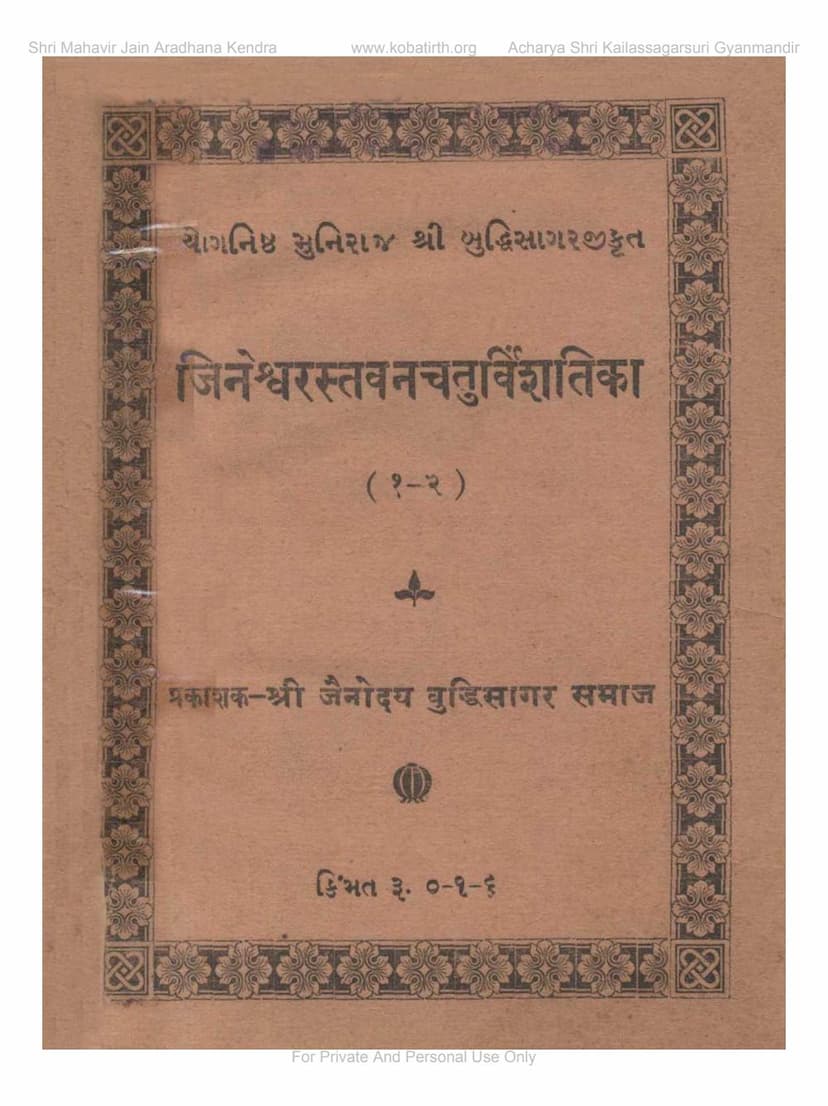Jineshwarstavan Chaturvinshtika
Added to library: September 2, 2025

Summary
This document is a Jain text titled "Jineshwarstavan Chaturvinshtika" (जिनेश्वरस्तवनचतुर्विंशतिका), authored by Yoganishtha Muniraj Shri Buddhisagarji. It is published by Shri Jainoday Buddhisagar Samaj, Sanand. The catalog link is provided for exploration.
The text is a collection of devotional hymns (stavan) dedicated to the 24 Tirthankaras (Jineshwar), who are revered figures in Jainism. The preface highlights the unique state of liberated souls and expresses a hope that readers can draw inspiration from the verses for their own spiritual progress and understanding of true fulfillment. It also thanks Sha. Veljibhai Motibhai for his support in publishing the book.
The core of the book consists of 24 individual stavan, each dedicated to a specific Tirthankara, starting from Rishabhdev and ending with Mahavir Swami. Each stavan is composed in a specific meter (raag) and offers praise and contemplation on the virtues and spiritual qualities of the respective Tirthankara.
Key themes and concepts explored across the stavan include:
- The nature of the soul (Atman): The stavan often emphasize the soul's inherent pure consciousness, its true nature, and the journey towards realizing this essence.
- The path to liberation (Moksha): The verses describe the Tirthankaras as guides and exemplars who have achieved liberation through their spiritual practices, self-discipline, and detachment. The stavan encourage devotion, meditation, and adherence to Jain principles as means to attain this goal.
- Philosophical concepts: Various Jain philosophical concepts are woven into the hymns, such as:
- Nayas (viewpoints): Different nayas like Sangraha, Vyavahar, Naigam, etc., are mentioned to understand the multifaceted nature of reality and the Tirthankaras.
- Nixhep (categories): Concepts like Dravya (substance), Kshetra (space), Kaal (time), and Bhav (mode) are used to analyze the Tirthankaras' qualities.
- Karma: The destructive and non-destructive karmas are discussed in the context of how Tirthankaras have overcome them.
- Anekantavada (many-sidedness): The principle of looking at things from multiple perspectives is implicitly or explicitly present.
- Syadvada (conditional predication): The nuanced approach to truth is also alluded to.
- Six substances (Shad-dravya): The fundamental entities of Jain philosophy are referenced.
- Avasthas (states): Different states of being and consciousness are explored.
- The Tirthankaras' attributes: Each stavan highlights unique aspects of the Tirthankara it is dedicated to, such as their omniscience (Kevalgyan), omnivision (Kevaldarshan), unique powers, and the specific teachings or events associated with them.
- Devotion and meditation: The stavan are presented as tools for devotion (bhakti) and meditation (dhyan), encouraging the reader to contemplate the Tirthankaras' lives and teachings to purify their own minds and souls.
- The role of the Guru: The preface and some stavan allude to the importance of spiritual teachers and the lineage of gurus in guiding the path.
The collection aims to inspire spiritual devotion and understanding of Jain philosophy, with the author, Buddhisagarji, aiming to make the path to self-realization accessible and engaging through poetic expression. The book is presented as a means for spiritual upliftment and attaining eternal happiness.